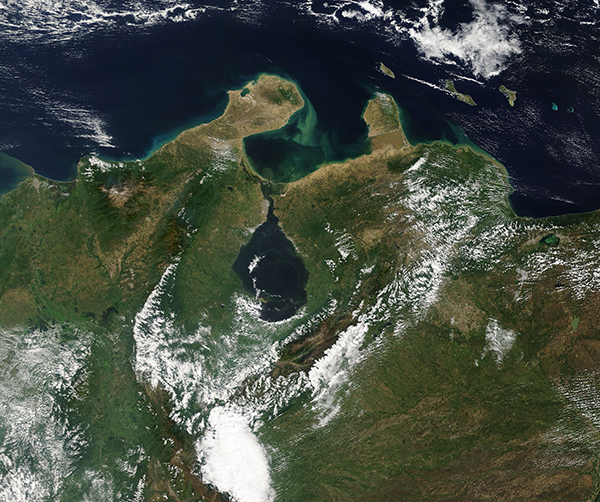Images
December 25, 2018 - Lake Maracaibo
Tweet
Close to the spot where Columbia meets Venezuela, the coastline of the Caribbean Sea folds inland, creating the Gulf of Venezuela. Near the southern tip of the Gulf a narrow, 34-mile (54-km) strait (Tablazo Strait) brings salty Caribbean water into the tidal Lake Maracaibo. Lake Maracaibo, the largest lake in South America, covers an area of 5,100 square miles (13,210 sq. km) and extends inland 100 miles (180 km).
The Maracaibo Basin is hot, humid, and almost entirely surrounded by mountains. As one of the major oil-producing areas of the world, it supports a large population working and living nearby. The second-largest city in Venezuela, Maracaibo, sits on the western shore of Tablazo Strait and is home to more than 2 million people.
Although Lake Maracaibo is considered an estuary, it receives fresh water from several lakes. The largest, the Catatumbo River pours into the lake near the southwestern end of the lake through a large delta. In this image, the Catatumbo Delta is hidden under a layer of cloud. Clouds are a common sight at this location. The area has the dubious honor of having the most lightning strikes in the entire world.
According to a study published in February 2016, Lake Maracaibo has a unique set of features that contributes to the development of deep convection at the same place 297 days per year on average, with maximum lightning storms occurring at night. Nocturnal thunderstorms over Lake Maracaibo are so frequent that their lightning activity was used as a lighthouse by Caribbean navigators in colonial times. The thunderstorms are locally known as the “Lighthouse of Catatumbo”, the “Never-ending storm of Catatumbo”, or simply Catatumbo lightning.
The Moderate Resolution Imaging Spectroradiometer (MODIS) on board NASA’s Terra satellite acquired this true-color image of Lake Maracaibo on December 10, 2018.
Image Facts
Satellite:
Terra
Date Acquired: 12/10/2018
Resolutions:
1km (817.2 KB), 500m (2.2 MB), 250m (2 MB)
Bands Used: 1,4,3
Image Credit:
MODIS Land Rapid Response Team, NASA GSFC
Tweet
Close to the spot where Columbia meets Venezuela, the coastline of the Caribbean Sea folds inland, creating the Gulf of Venezuela. Near the southern tip of the Gulf a narrow, 34-mile (54-km) strait (Tablazo Strait) brings salty Caribbean water into the tidal Lake Maracaibo. Lake Maracaibo, the largest lake in South America, covers an area of 5,100 square miles (13,210 sq. km) and extends inland 100 miles (180 km).
The Maracaibo Basin is hot, humid, and almost entirely surrounded by mountains. As one of the major oil-producing areas of the world, it supports a large population working and living nearby. The second-largest city in Venezuela, Maracaibo, sits on the western shore of Tablazo Strait and is home to more than 2 million people. Although Lake Maracaibo is considered an estuary, it receives fresh water from several lakes. The largest, the Catatumbo River pours into the lake near the southwestern end of the lake through a large delta. In this image, the Catatumbo Delta is hidden under a layer of cloud. Clouds are a common sight at this location. The area has the dubious honor of having the most lightning strikes in the entire world.
According to a study published in February 2016, Lake Maracaibo has a unique set of features that contributes to the development of deep convection at the same place 297 days per year on average, with maximum lightning storms occurring at night. Nocturnal thunderstorms over Lake Maracaibo are so frequent that their lightning activity was used as a lighthouse by Caribbean navigators in colonial times. The thunderstorms are locally known as the “Lighthouse of Catatumbo”, the “Never-ending storm of Catatumbo”, or simply Catatumbo lightning.
The Moderate Resolution Imaging Spectroradiometer (MODIS) on board NASA’s Terra satellite acquired this true-color image of Lake Maracaibo on December 10, 2018.
Image Facts
Satellite:
Terra
Date Acquired: 12/10/2018
Resolutions:
1km (817.2 KB), 500m (2.2 MB), 250m (2 MB)
Bands Used: 1,4,3
Image Credit:
MODIS Land Rapid Response Team, NASA GSFC




